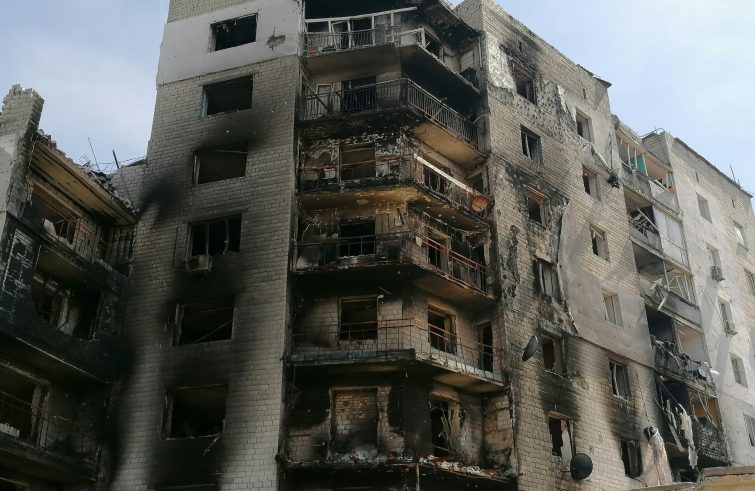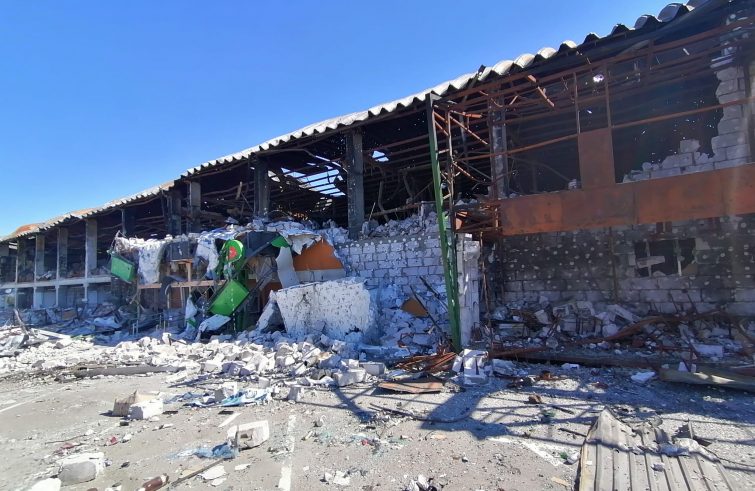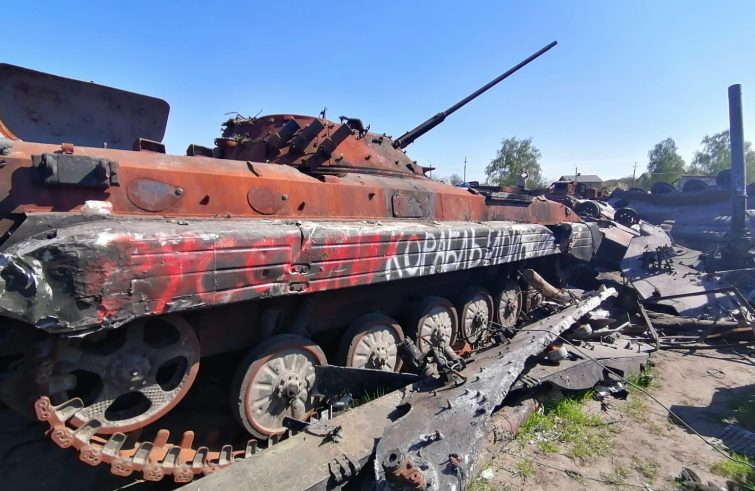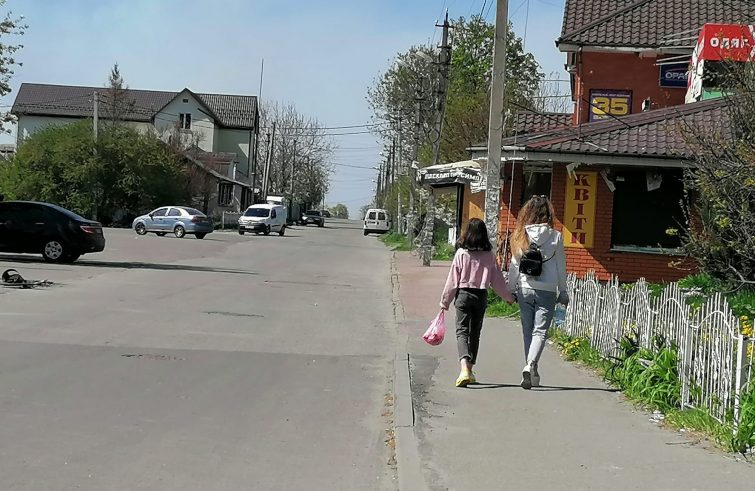
“Slava Ukraini”, Glory to Ukraine: a driver greets a heavily armed soldier guarding the checkpoint from his lowered car window. “Heroiam slava!”, Glory to the heroes, he replies. A rapid yet meticulous ID inspection is followed by a green light. Huge concrete blocks, Czech hedgehogs and sandbags placed on the road between the city of Kyiv and the neighbouring towns of Bucha, Irpin and Borodyanka, all located within the space of just a few dozen kilometres, force vehicles to slow down and proceed on a long obstacle course, under the military’s constant scrutiny. The remains of trenches dug by Ukrainian troops to counter the Russian military advance that was halted in this area are visible in the surrounding woods. What was intended to be a triumphant march of the Russian troops towards Kyiv turned out to be the Russians’ dismal retreat.
Huge billboards lining the road praise the courage and valour of the Ukrainian soldiers. One of these posters, virtually destroyed by bad weather, bears the number ‘450’, which in Ukrainian military jargon means ‘I’m OK’. It’s a coded language used by soldiers to communicate with their families in a safe and fast way from the battlefront. Another poster exhorts to “enlist in the army because the future of Ukraine is in your hands.” Patriotic slogans – “courage is a Ukrainian hallmark” – also feature in shop windows along the main streets of the capital, as it slowly tries to restore a semblance of normality. Pre-war traffic jams are a thing of the past, with an estimated 400,000 inhabitants having left Kyiv because of the war. Independence Square, better known as Majdan Square, is deserted and garrisoned by the soldiers. Rushing to basements during the air raids now seems to be but a distant memory. Red tulips adorn the hedges of the square in memory of Ukrainian and foreign victims of the war. Those who know of a person who died for the Ukrainian cause can take a yellow and blue flag, write their name on it and place it on the memorial lawn. A city-wide curfew is in force from 11pm to 5am, while in Kyiv the curfew begins at 9pm. Because of the Russian celebrations on May 9 to mark the victory over the Nazis in World War II, Ukrainian authorities have decided to extend the curfew this weekend. A two-day curfew is in place in the Kyiv region on May 8 and 9. There is a high risk of Russian shelling in the Kyiv region, according to Ukrainian security officials, thus precautionary measures are being taken. In a Telegram message, President Zelenskiy asked all citizens not to ignore air raid alerts, to respect the curfew and not to enter the woods, formerly occupied by the Russians, to avoid falling in mined areas.
The towns of Bucha, Irpin and Borodyanka, previously occupied by the Russians – who committed massacres, looting and destruction before retreating – are also trying to restart. The mass grave where over 100 bodies of civilians were found, massacred by the Russians, located in a field beside St. Andrew’s Orthodox Church, has now become a site for prayer, with people coming to lay flowers. The bodies lining the streets, televised worldwide, have been collected for burial, and bullet-ridden vehicles have also been removed. But the memory of those days remains. People are trying to dispel the fear of war by repairing their homes and removing the rubble. Flower beds have bloomed here and there. There are long lines of cars at the gas stations. Fuel has been rationed to a maximum of 10 litres per person. But opinions differ: some believe that the rationing is caused by the conflict while others believe it to be the result of speculation by oil companies that are waiting for the government to give the go-ahead for a fuel price increase.
- (Foto SIR)
- (Foto SIR)
- (Foto SIR)
A sort of war cemetery in nearby Irpin has been created, it features the charred carcasses of Russian tanks destroyed by the Ukrainians. Local residents come here to collect parts of these tanks to reuse as building materials for their homes. This may also be a way of recovering what the Russians had robbed them of, their property and homes. Some of these torched tanks display insults against the Russian army and Putin. A white van is marked with the words “mines.” The Russians have left plenty of mines in the woods and along the roads. A few hundred metres ahead stands what remains of a shopping centre hit by Putin’s missiles. Attempts are being made to calculate the damage, which is huge. Brand new electrical cables hang from a light pole facing the rubble. Two workers at the site tell us that their first task is to restore electricity. The local hospital is also being repaired, and physicians have painted red crosses on the outside walls to avoid being hit by missiles.
The same happened in Borodyanka, one of the most heavily shelled villages by Russian air forces on March 1st and 2nd. On those days, the Russian troops stopped the local firefighters from evacuating people who were still trapped under the rubble. It was not until mid-April that some of the corpses were extracted. The entrance to the city is a massive line of bomb-blackened and completely gutted buildings. Walls of residential buildings and apartment blocks have been marked with a “V” by the Russian army, an identifying mark attributable to auxiliary troops, probably Chechen battalions. Fragments of broken lives, stuffed animals, garments on hangers and pieces of furniture can be seen amidst the rubble. On a bench, not far from a building whose architecture is reminiscent of that of the ex Soviet Union, a young couple is talking on the phone with friends. It was here that UN Secretary-General Antonio Guterres arrived on April 28. Speaking before these 10-storey buildings, he condemned the destruction, “an unacceptable absurdity in the 21st century.” Before him, on Good Friday (April 15), the papal almoner, Cardinal Konrad Krajewski, and the apostolic nuncio in Kyiv, Archbishop Visvaldas Kulbokas, prayed together in front of a tomb where at least 80 people were buried without names or surnames.
- (Foto SIR)
- (Foto SIR)
- (Foto SIR)
The nuncio was deeply moved by the “bodies of boys and girls torn apart and tortured with bottles, pulled out from under the rubble”, as he told SIR during a meeting in Kyiv with a delegation of Aid to the Church in Need. As he left Borodyanka, the nuncio was carrying with him an undamaged copy of the New Testament found by firefighters in an apartment on the eighth floor of a burnt-out building, as well as a Bible found under the rubble. Two relics, two symbols of future hope. And a harbinger of hope is a mother from Borodyanka holding hands with her daughter as they return home. They are awaiting the father fighting on the battlefield. “Slava Ukraini”.

















